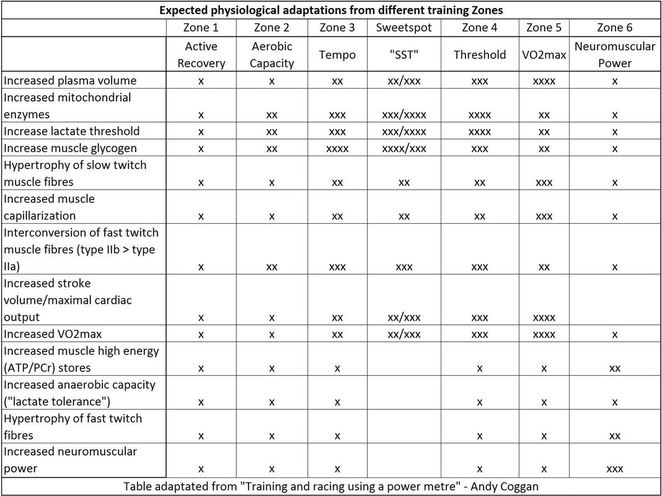Interesting question @StabbingQTip. Lots of good responses in here already.
It sounds like the core of your question is whether sub-threshold work actually effective, or if it’s just there to help us avoid burning out from all the over-threshold work that does the real job? Is that right?
The short answer is:
No, Under-FTP work isn’t less beneficial. It’s differently beneficial.
This chart adapted from Andy Coggan’s work is a great visual if you’re into the physiology side. It shows how different training zones target different systems. Some adaptations are best developed with sub-threshold work, others respond more to over-threshold. Both matter.
As others have mentioned already, you can absolutely get faster training just under or just over FTP. But the way you get faster depends on which type of work you focus on, and that shapes the kind of rider you become.
To keep it simple:
- Training below FTP (like Sweet Spot or Threshold) helps you become more efficient, increase muscular endurance, and hold power longer.
- Training above FTP (like VO₂max intervals) helps improve your max aerobic capacity and ability to recover from repeated hard efforts.
Neither is better across the board, it depends on your goals and the demands of your event.
Keep in mind that it’s not just what you train, it’s when you train it. Plan periodization is important and different workouts serve different roles depending the training phase.
In that podcast clip you referenced, Nate was talking specifically about the Specialty phase, where the goal isn’t to raise your FTP but rather to shape the fitness you already built so it matches the demands of your event.
This is an important distinction. Even if more threshold work nudges your FTP up a few watts, it may not improve your performance, especially if those efforts don’t reflect what you’ll face on race day.
For example, if you’re training for a criterium, prioritizing suprathreshold efforts that include on/offs, hard starts, and sprint surges is far more beneficial than another round of steady-state 2×20s. That’s not because threshold work is bad, but because those efforts build the kind of repeatability and responsiveness that steady-state threshold intervals like 2×20 simply don’t target.
Of course, mental side of training does matter. A plan only works if you can stick with it. Sub-threshold efforts tend to be more repeatable and less mentally taxing, which helps you stay consistent and avoid burnout. But that’s not the only reason they’re in your plan.
What would the two outcomes look like for athlete A that spends all of their 80 TSS “over” vs athlete B that spends all of theirs “under?”
We’re brushing aside a lot of important context here - training history, fatigue, recovery, phase of training, individual response to intensity, etc. But to answer the spirit of the question, let’s assume both athletes have the same FTP, background, and overall fitness profile. With all else equal, generally you would expect:
-
Athlete A (over FTP) - would be more optimized for surgy, high-intensity efforts. You’d expect better VO₂max, lactate clearance, and repeatability. Great for criteriums, cyclocross, or punchy road races but may struggle with long, steady efforts.
-
Athlete B (under FTP) - would develop better muscular endurance and fatigue resistance. Likely more comfortable with long climbs, solo breakaways, or other events that require long but intense efforts.
Finally, what it’s worth, @AJS914 referenced the right study here. The Hickson et al. (1977) paper is the one Nate was referring to in that podcast clip.
Hope this helps! I know it’s a lot, so feel free to let me know if you have any other questions.
